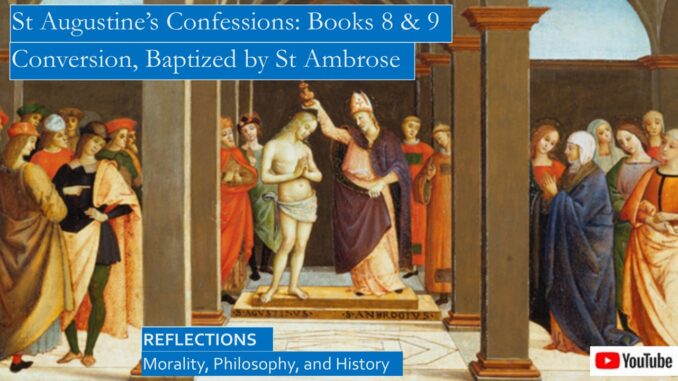
Why should we reflect the young St Augustine’s conversion and baptism in Books 8 and 9 of his spiritual autobiography, the Confessions?
Why can’t you simply believe in Christian teachings? Must you join a church? Do the walls of a church make you a Christian?
Why did the Life of St Anthony deeply affect so many Christians?
What event convinced young Augustine to finally convert?
Shortly before her death, St Monica experienced a joint beatific vision with her son, St Augustine, which is one of the few joint visions experienced by the saints.
YouTube Video: Confessions of St Augustine, Youth and Adolescence, Books 1 and 2
https://youtu.be/gdK1a3AbI9w
St Augustine’s Confessions: Manichaeism, NeoPlatonic Philosophy, and Monica’s Prayers, Books 3, 4, and 5
https://youtu.be/ydskqlgZSrE
St Augustine’s Confessions: Mother Monica, Concubine, Marriage, and Philosophy, Books 6 & 7
https://youtu.be/AjGbBozIReY
St Augustine’s Confessions, His Conversion, Baptism, St Monica’s Death, and Philosophy, Books 8 & 9
https://youtu.be/Vijtjxm3Ta0
Powerpoint script, with Amazon book links:
https://www.slideshare.net/BruceStrom1/st-augustines-confessions-his-conversion-baptism-st-monicas-death-and-philosophy-books-8-9
St Augustine’s Confessions, Memory, Soul and Mind Book 10
https://youtu.be/xTHmGhGG6Bk
St Augustine’s Confessions, Time, Creation Genesis, Pagan Myths, and Manicheism Books 11, 12, and 13
https://youtu.be/Ff-XsE5CuSo
ST AUGUSTINE’S CONFESSIONS, BOOKS 8 and 9
The Confessions were written soon after St Augustine was drafted to be the co-bishop of Hippo, near Carthage. The Confessions are not only a confession of faith and a confession of sin and sinful longings, but also, they are cast into a prayer to God, exploring his inmost motivations.
We previously reflected on Books 1 and 2, on Augustine’s Youth and Adolescence, including when Augustine and his hooligan friends steal a neighbor’s pears from his orchard. St Augustine compares this to the Original Sin of Adam and Eve eating the apple in the Garden of Eden.
In the subsequent books, Books 3 through 5, he describes the years spent in the Manichean heresy, turning his back on the Christianity of his mother Monica.
In Books 6 and 7: Monica plans a politically advantageous marriage and convinces him to send his concubine back to North Africa. His study of NeoPlatonic philosophy, along with the sermons of St Ambrose, leads him back to Christianity.
We reviewed in our reflections on Books 3, 4, and 5 the differences between Christianity, where the Almighty God is the source of all goodness, where evil is but a corruption of the good, and the dualistic Manichean system, where good and evil are more or less equal, and eternally battle for supremacy. [1]
| Christian Beliefs | Manichaeism Beliefs |
| Almighty God is omniscient, omnipresent, goodness itself | Dualistic cosmological struggle between light and darkness |
| Evil is a corruption of the good and the absence of virtue | Evil and virtue are co-equal, eternally engaged in struggle |
| Jesus Christ is the Son of God | Jesus is another prophet |
| Based on Jewish Old Testament | Derived from Zoroastrianism |
| Old Testament is Holy Scripture | Old Testament was corrupted to impose Judaism on Christianity |
| After death is judgment and resurrection of the body | Belief in reincarnation, only the perfect break free to Paradise |
YOUNG AUGUSTINE AS CATECHUMEN UNDER ST AMBROSE
Baptism and confession in ancient Rome were very viewed much more seriously than they are today, as the Christian persecutions were in living memory. St Augustine was baptized in the year 387 while the former Emperor Constantine the Great started favoring Christianity in the year 312, putting to an end the vicious persecution of Christians under the preceding Emperor Diocletian, which was only seventy-five years ago.
Although the severe Diocletian persecutions were fading into history, many Christians had parents or grandparents who suffered and martyred for their Christian faith. There was a strong feeling among the Christians that they needed to be serious about baptism, that committing mortal sins after baptism could endanger their immortal soul. Constantine was baptized on his deathbed since he feared damnation for those enemies that were killed on the battlefield. Monica had delayed her son’s baptism because she was not sure he could repent of the inevitable sins teenagers with raging hormones would commit, and he declined to be baptized until he left the Manichean heresy in his middle age. Many Christians in the time of St Augustine desired to be as serious about their faith as the martyrs were about the faith that they sacrificed their life for.
This explains Augustine’s anxieties as he prepares himself for the challenge of living as perfect a Christian life as possible after his baptism. His anxiety was that he could not control his passions, a common concern in a Roman world so deeply influenced by Stoic philosophy. St Augustine tells us several conversion stories that were shared with him before his own conversion story.
VICTORINUS: DO THE WALLS MAKE THE CHURCH?
Although St Augustine may not have conversed with Bishop Ambrose outside any catechumen classes he likely hosted, he did converse with Simplicianus, who was the spiritual father, and likely confessor, of Bishop Ambrose. When he discussed how he studied the writings of the NeoPlatonists, seeing some similarities between their philosophy and Christian beliefs, and his spiritual struggles and doubts, Simplicianus told him the story of Victorinus of Rome some years prior.
St Augustine remembers, “Victorinus was an old man of great learning, with a profound knowledge of all the liberal sciences. He had studied a great many books of philosophy and published criticisms of them. He had been master to many distinguished members of the Senate, and to mark his outstanding ability as a teacher, he had even been awarded a statue in the Roman forum, a great honor.”
St Augustine continues, “Victorinus had read the Holy Scriptures, and made the most painstaking and careful study of all Christian literature. Privately, between friends, though never in public, he used to say to Simplicianus, ‘I want you to know that I’m now a Christian.’ Simplicianus replied, ‘I shall not believe it or count you as a Christian until I see you in the Church of Christ.’ At this, Victorinus would laugh and say, ‘Is it then the walls of the church that make the Christian?’”
St Augustine continues, “But later on, as a result of his attentive reading, he became resolute. He was seized by the fear that Christ might deny him before the holy angels if he was too faint-hearted to acknowledge Christ before men, and he felt himself guilty of a great crime in being ashamed of the sacraments instituted by Your Word in his lowly state.”[2]
His studies answered his question, Victorinus came to realize that, indeed, the walls of the church do make the Christian. He submitted his name to the bishop to be baptized the next Easter publicly in the church, to his fellow Christians in public worship of Christ, encouraging one another, as Hebrews states.
INSPIRING CLASSIC: LIFE OF ST ANTHONY
St Augustine heard another conversion story of two friends who were staying in the house of an acquaintance, where they discovered and read the Life of St Anthony. He heard a priest preach how Jesus exhorted us that if you wish to be perfect, to sell all you own, and come, follow me. St Anthony felt that this verse was directed at him, so he sold all that he owned, moved out to the deserts of Egypt, and lived the solitary life of a hermit, inspiring many with his wisdom and kindness.
Life of St Anthony: https://youtu.be/2sR8OCZqzFw
St Augustine remembers: They began to read the Life of St Anthony, and one of them “was so fascinated and thrilled by the story, that even before he had finished reading, he conceived the idea of taking upon himself the same kind of life and abandoning his career in the world” “in order to become your servant, O God. All at once he was filled with the love of holiness. Angry with himself and full of remorse, he looked at his friend and asked, ‘What do we hope to gain by all our efforts?” “What are we looking for? What is our purpose in serving the state? Can we hope for anything better at court than to be the emperor’s friends?”
St Augustine continues, “While he was reading, his heart leaping and turning in his breast,” he cried out to “his friend, ‘I have torn myself free from all our ambitions and have decided to serve God from this very moment, here and now, I shall start to serve him. If you won’t follow my lead, do not stand in my way.’ His friend answered that he would stand by him, his comrades for such service was glorious and the reward was great.”[3]
CONVERSION IN THE GARDEN: TAKE AND READ
St Augustine describes, in many chapters, the internal anguish he suffers as he struggles to control his passions in preparation for his new spiritual life after baptism. St Augustine prays to God: “You never depart from us, yet it is hard for us to return to you.”[4] He also prays: “My thoughts, as I meditated upon You, were like the efforts of a man who tries to wake but cannot and sinks back into the depths of slumber.”[5]
St Augustine describes the climax of his internal spiritual struggle. He remembers: “There was a small garden attached to the house where we lodged. We were free to make use of it as well as the rest of the house.” “I found myself driven by the tumults in my breast to take refuge in this garden where no one could interrupt that fierce struggle, in which I was my own contestant.” “Meanwhile, I was beside myself with madness that would bring me sanity. I was dying a death that would bring me life. I knew the evil that was in me, but the good that was soon to be born in me I did not know.” His friend Alypius followed him into the garden. “I was frantic, overcome by violent anger with myself for not accepting your will and entering into your covenant, O God.”[6] And St Augustine wrestles with the forces of darkness and light, and Manichean dualism and Christian monotheism, and his human passions for another few chapters.
How was his internal anguish resolved? St Augustine remembers: “I was asking myself many questions, weeping all the while with the most bitter sorrow in my heart, when all at once I heard the sing-song voice of a child in a nearby house,” “again and again it repeated the refrain, ‘Take it and read, take it and read.’” “I stemmed my flood of tears and stood up, telling myself that this could only be a divine command to open my book of Scripture and read the first passage on which my eyes should fall.”
This reminded him of the story of St Anthony, how he had heard the words in church preached by Jesus to those who wished to strive for perfection: “Go home and sell all that belongs to you. Give it to the poor, and so the treasure you have shall be in heaven; then come back and follow me.”
St Augustine continues: “In silence I read the first passage on which my eyes fell: ‘Not in reveling and drunkenness, not in lust and wantonness, not in quarrels and rivalries, but rather, arm yourself with the Lord Jesus Christ; spend more no more thought on nature and nature’s appetites.’ I had no wish to read more and no need to do so. For in an instant” “it was as though the light of confidence flooded into my heart and all the darkness of doubt was dispelled.”
St Augustine praised God: “You converted me to yourself, so that I no longer desired a wife or placed any hope in the world, but stood firmly upon the rule of faith, where you had shown me to her,” his mother Monica, “in a dream so many years before. And you turned her sadness into rejoicing, into joy far fuller than her dearest wish, far sweeter and more chaste than any she had hoped to find in children begotten of my flesh.” He is referring to the dream dreamt by his mother Monica so many years before, when she was praying for reassurance that his soul would not be lost.[7]
DUAL VISION WITH HIS MOTHER, ST MONICA. AND HER DEATH
After his baptism, St Augustine with his family and friends had decided to give up their life at court in Milan and sail back to North Africa, where they would spend their lives as ascetic. Waiting for a ship to arrive, they spend time at a home with a garden in Ostia. There the Teaching Company or Great Courses Professor Philip Cary says that St Augustine and his mother St Monica, “talking at the window of a garden, have a dual vision of eternal wisdom, a joint mystical vision, with St Augustine representing reason and wisdom, and St Monica representing faith and authority, demonstrating that philosophy and faith can go together.” This is the one of the few dual visions that are recorded in the lives of the saints.[8]
St Augustine remembers, praying to the Lord: “Not long before the day in which she was to leave this life, you know which day it was to be, Our Lord, though we did not, my mother and I were alone, leaning from window which overlooked the garden in the courtyard of the house where we were staying at Ostia.”
St Augustine continues: “Our conversation led us to the conclusion that no bodily pleasures, however great it might be and whatever earthly light might shed luster upon it, were worthy of comparison” “beside the happiness of the life of the saints. As a flame of love burned stronger in us and raised us higher towards the eternal God, our thoughts ranged over the whole compass of material things in their various degrees, up to the heavens themselves, from which the sun and the moon and the stars shine down upon the earth. Higher still we climbed, thinking and speaking all the while in wonder at all that you have made.”
St Augustine continues: “My mother said: “My son, for my part, I find no further pleasure in this life. What am I still to do or why am I here in the world, I do not know, for I have no more to hope for upon this earth. There was one reason, and one alone, that I wished to remain a little longer in this life, that was to see you a Christian before I died. God has granted my wish and more besides, for now I see you as a servant spurning such happiness as the world can give. What is left for me to do in this world?”[9]
“It was about five days after this that she took to her bed with a fever. One day, during her illness she had a fading fit and lost consciousness for a short time.” When she came to, she asked, “Where was I?” His brother told her that he would wish that, “for her sake, she would die in her own country, not abroad.”
Monica heard this and responded, “It does not matter where you bury my body. Do not let that worry you! All I ask of you is that, wherever you may be, you should remember me at the altar of the Lord.” “And so, on the ninth day of her illness when she was fifty-six and I was thirty-three, her pious and devoted soul was set free from the body.”[10]
St Augustine fondly remembers: “I closed her eyes and a great wave of sorrow surged into my heart. I would have overflowed in tears if I had not made a strong effort of will and stemmed the flow, so that the tears dried in my eyes. What a terrible struggle it was to hold them back! As she breathed her last, my boy Adeodatus began to wail aloud and only ceased his cries when we all checked him. I, too, felt like I wanted to cry like a child, but a more mature voice within me, the voice of my heart, bade me to keep my sobs in check, and I remained silent. For we do not think it right to mark my mother’s death with weeping and moaning, because such lamentations are the usual accompaniment of death when it is thought of as a state of misery or as total extinction. But she had not died in misery, nor had she wholly died,” as she would one day be resurrected.
We must keep in mind that the ancient world is a different world than the modern world. The stoicism of the ancient world, a world where the mortality rate was much higher, and death came upon men much sooner.
St Augustine lamented, “It was misery to feel myself so weak a victim of these human emotions, although we cannot escape them, since they are the natural lot of mankind, and so I had the added sorrow of being grieved by my own feelings, so that I was tormented by twofold agony.”
St Augustine remembered that before her death, “with great emotion she told me that she could not remember ever having heard me speak a single hard or disrespectful word against her.” [11] He also remembered fondly that his mother Monica “always acted with mercy and that she forgave others with all her heart when they trespassed against her.” He prays to the Lord: “Forgive her too, O Lord, if she ever trespassed against you in the long years of her life after baptism.”[12]
TRAVAILS OF ANCIENT ROMAN WIVES
When reading these ancient books, we are often reminded that the ancient world was very different from the modern world. We are reminded of this from comments made by St Augustine in praise of his mother Monica.
St Augustine says, “Many women, whose faces were disfigured by blows from husbands far sweeter tempered than her own, used to gossip together and complain of the behavior of their menfolk. My mother would meet this complaint with another, about the women’s tongues. Her manner was light but her meaning serious. When she told them that ever since they had heard the marriage deed read to them, they ought to have regarded it as a contract which bound them to serve their husbands. From that time onward, they should remember their condition and not defy their masters. These women knew well enough how hot-tempered a husband my mother had to cope with.”
Which tells us that, in many ways, wives in the ancient world were regarded as a privileged type of slave, and that men reigned supreme as masters of their household, and could do whatever they liked to their wives, and the wives had no real recourse. There really weren’t any police you could call in the ancient world.
Ordinary Life and Justice in Ancient Greece: https://youtu.be/vl8KGL5Yx2w
St Augustine adds another, less disturbing, compliment about Monica early in her marriage: “Her mother-in-law was at first prejudiced against her by the gossip of malicious servants, but she won the older woman over by her dutiful attentions and her constant patience and gentleness.”[13]
ST AMBROSE BAPTIZES YOUNG AUGUSTINE
St Augustine says this about his actual baptism: “We were baptized,” St Augustine, his son Adeodatus, and his friend and former student Alypius, “and all anxiety over the past melted away from us. The days were all too short, for I was lost in wonder and joy, meditating upon your far-reaching providence for the salvation of the human race. The tears flowed from me when I heard your hymns and canticles, for the sweet singing of your Church moved me deeply.” And he wept “tears of gladness.”[14]
This is the climax of the story, his baptism, and though St Augustine relates his spiritual thoughts and feelings over many pages and chapters and books, the only details he provides about his baptism was that there were hymns and canticles!
Fortunately, the skilled biographer Peter Brown has pieced together from many sources a description of a fourth-century baptism.
Peter Brown writes, “In Milan, Augustine, Adeodatus and Alypius became competentes, joining those who ‘begged’ baptism at the hands of Ambrose on the next Easter on the night of the year 387.” Peter Brown uses the word begged, as baptism was seen as an initiation rite of passage, being baptized was an honor for those who pledged to live as perfect a godly life as was humanly possible.
Peter Brown continues, “As a competens, Augustine would have received solemn instructions from Bishop Ambrose himself. Ambrose never spared himself in directing this momentous initiation, and Augustine was deeply affected by what he heard when, after the main celebration of the liturgy, the competentes assembled in the baptistry adjoining the main basilica to hear their bishop.”
Peter Brown quotes from a work penned by St Augustine: “Are we so out of touch with our feelings as to not remember how conscientiously and with what anxiety we heard those who taught the catechism laid down for us, when we begged the sacraments of that fount of life?”
Keep in mind, during this time there were many pagans who were choosing to convert to Christianity. There are many scholars who argue that the mystery cults, such as the cult of Mithras, had similar initiation rites, demanding higher moral behavior of the initiate. While this argument has merit, it can be overdrawn. We encountered an example in our reflections on The Golden Ass, where the proponent, Lucius, was first turned into a donkey, and was turned back into human form in the last chapter at the instruction of the all-powerful Goddess Isis. While there were mild mentions of the need for moral behavior, clearly Isis desired most of all to have yet another human who would worship her.
Metamorphosis of Apuleius, the Golden Ass, Possible Inspiration for Pinocchio: https://youtu.be/PZuFkxhfOaI
Peter Brown continues, “The catechism of Milan was still an awesome discipline, calculated to intimate, to converted pagans, mysteries which until that moment had been hidden from the outside world: even the Lord’s prayer was not ‘handed over’ to the believer until he had passed through his initiation. Augustine heard, and remembered, solemn warnings against polytheism and idolatry, the precise way in which God had taken on human flesh would have been revealed, and the hard and, to pagans quite alien, doctrine of personal retribution after death, would have been brought home to the listeners repeatedly.”
The baptism Peter Brown describes is similar to the Wednesday night full-immersion baptisms I witnessed while attending a Baptist Church. The baptismal pools were above the front of the church, and the sides of the pool were visible to the congregation so they could witness the baptism. Infants were not baptized, the baptized donned white robes and walked down into the chlorinated pool and were immersed in crystal-clear chilly water.
The Didache, the earliest writing of the Apostolic Church Fathers, after the epistles of the Bible, teaches that the preferred method of baptism is in living, flowing water, as in a river, followed by immersion in still water, followed by sprinkling of baptismal water, which was preferred for infant baptisms.
The Didache, Early Church Writing: https://youtu.be/vcNK5_xpEh4
Peter Brown continues, “At Easter, the right of baptism itself emphasized the momentous nature of the transformation which Augustine was undergoing. On the eve of the resurrection, Augustine and the throng of other competentes of all ages and both sexes, would troop to the baptistry beside the main basilica of Ambrose. Passing behind curtains, Augustine would descend, alone, stark naked, into a deep pool of water. Three times, Ambrose would hold his shoulders beneath the gushing fountain.”
This description by Peter Brown reminds me of the Orthodox services, with their fondness for candles: “Later, dressed in a pure white robe, the competens would enter the main basilica ablaze with candles; and amid the acclamations of the congregation, he and his fellow neophytes would take their place in a slightly raised floor by the altar, for their first participation in the mysteries of the risen Christ.”
Peter Brown also repeats the Church teaching that Christ descended to take human form, living among us, teaching us, dying for our sins, so we could be empowered to ascend to heaven, empowered by the grace of God and the Holy Spirit to live a more perfect godly life, to become adopted sons of the Father. “The theme of ‘putting off the old’ and ‘putting on the new’, of rebirth and rising again from death, of the consequent ascent of the soul to heaven made possible by the descent of Christ to earth, reverberated in Augustine’s imagination.”
Peter Brown points to the future: “In the next years, Augustine wove his own refined NeoPlatonic doctrine of the ascent of the soul from the ‘old man’ of the senses, around this elemental and mysterious action.” [15] Peter Brown’s footnote refers to St Augustine’s work, De quantitate animae, or De animae quantitate in English, “The Greatness of the Soul.” This is not included in the Nicene and Post-Nicene Church Fathers collection, but it is own of his earliest writings, written shortly after his Soliloquies.[16] St Augustine wrote another later work on the Origin of the Soul included in the collection of his anti-Pelagian writings. This reference piques my curiosity, so this will likely be a future video.
How To Read Ancient Works, and Book Reviews on the Apostolic Church Fathers
https://youtu.be/I_2q4BiRBlU
FUTURE REFLECTIONS ON ST AUGUSTINE’S CONFESSIONS
We will definitely dedicate one reflection solely to Book X of the Confessions, this is St Augustine’s summation of his new Christian beliefs, this is the spiritual climax of his Confessions.
This is the summary in the Table of Contents of the Pine-Coffin translation:
- “Augustine asks his readers to thank God for his conversion and to pray for him.
- Augustine ponders the powers of memory.” This is the section that was the most challenging the first time I read the Confessions; we will review this section in two translations.
- Since all men long for happiness, they must know:” What is happiness?.
- St Augustine examines his ability to master the various temptations of the body.
- If we have power to resist our temptations, it is by God’s grace.
- Only through Christ, the true Mediator, can we hope to be reconciled with God.[17]
Do not skip the final chapters on his new-found interpretation of Genesis! This concludes his spiritual progress, as he comes to a fuller understanding of Creation and the nature of God as understood by the Holy Scriptures and the Church Fathers. This corrects his formerly heretical views when he was a Manichee, which are similar to many modern heresies spread on the internet. Whether this will be one video or more we will discover later.
DISCUSSION OF THE SOURCES
St Augustine was an excellent orator and writer, but the Confessions is the most beautifully crafted and closely edited of his works, and there are many translations.
We also consulted Peter Brown’s Biography on St Augustine for his description of how baptisms were experienced during ancient times. We were reminded that whenever we read these scholarly works, always be attentive to the footnotes! Often these provide rich avenues for further exploration.
Please view the first video for more comments on my sources.
I was so impressed by the lectures of Professor Philip Cary of the Teaching Company on Augustine: Philosopher and Saint, that I quoted from them as if they were another source. This is one of my favorite sets of lectures. Back in the day, he was one of the most popular Great Courses/ Teaching Company lecturers. It has not been transferred to Wondrium.
Another key set of Great Courses lectures that have been picked up by Wondrium is Professor Kenneth Harl’s The Fall of the Pagans and the Origin of Medieval Christianity, we reference his lecture on the Mystery Cults, including Mithraism. He has excellent lectures on Christian NeoPlatonism, the persecutions, Stoicism, Constantine the Great, and the Latin theologians, including St Augustine and Origen, and St Ambrose and St Jerome, and many others.
[1] Eusebius, The History of the Church or Ecclesiastical History, Book 30, pp. 319-230 and https://en.wikipedia.org/wiki/Manichaeism and St Augustine, Confessions, Book 5, Chapter 11, pp. 105-106.
[2] St Augustine, Confessions, translated by RS Pine-Coffin (New York: Dorset Press, 1986, 1961, originally 400 AD), Book 7, Chapter 2, pp. 159-161.
[3] St Augustine, Confessions, Book 8, Chapter 6, pp. 167-168.
[4] St Augustine, Confessions, Book 8, Chapter 3, p. 163.
[5] St Augustine, Confessions, Book 8, Chapter 5, p. 165.
[6] St Augustine, Confessions, Book 8, Chapter 8, pp. 170-171.
[7] St Augustine, Confessions, Book 8, Chapter 12, pp. 177-179.
[8] Phillip Cary, Augustine, Philosopher and Saint, The Great Courses, 1997.
[9] St Augustine, Confessions, Book 9, Chapter 10, pp. 196-198.
[10] St Augustine, Confessions, Book 9, Chapter 11, pp. 199-200.
[11] St Augustine, Confessions, Book 9, Chapter 12, pp. 200-201.
[12] St Augustine, Confessions, Book 9, Chapter 13, p. 203.
[13] St Augustine, Confessions, Book 9, Chapter 9, p. 195.
[14] St Augustine, Confessions, Book 9, Chapter 6, p. 190.
[15] Peter Brown, Augustine of Hippo, Biography (Berkeley and Los Angeles: University of California press, 1967 and 2000), Chapter 11, pp. 117-118. On Mithraism: Kenneth Harl, The Fall of the Pagans and the Origins of Medieval Christianity, The Great Courses, 2011, Lecture 4, The Mystery Cults, and also https://en.wikipedia.org/wiki/Mithraism
[16] https://en.wikipedia.org/wiki/Augustine_of_Hippo_bibliography
[17] St Augustine, Confessions, Table of Contents, p. 7.

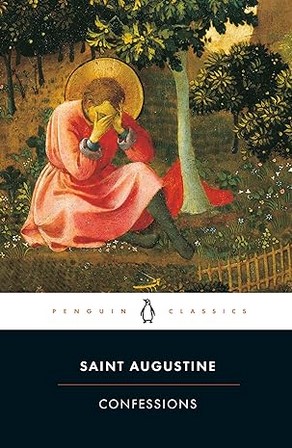
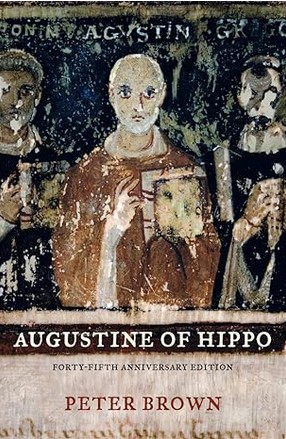
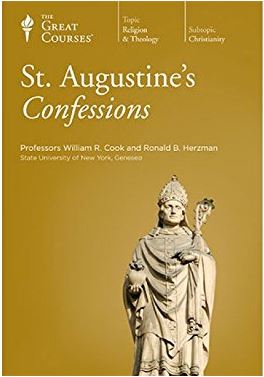
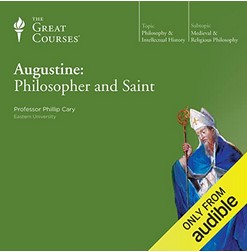
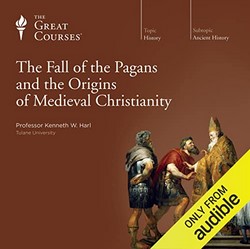
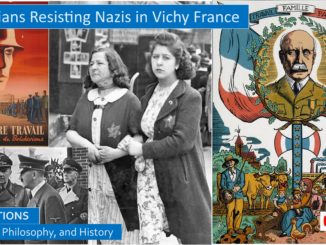
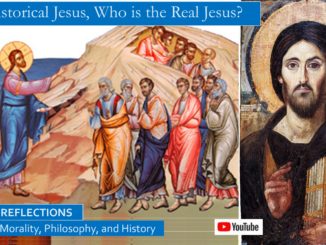
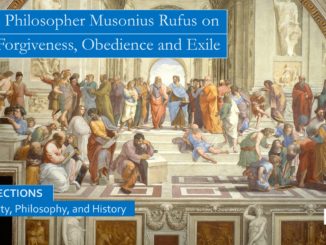
1 Trackback / Pingback